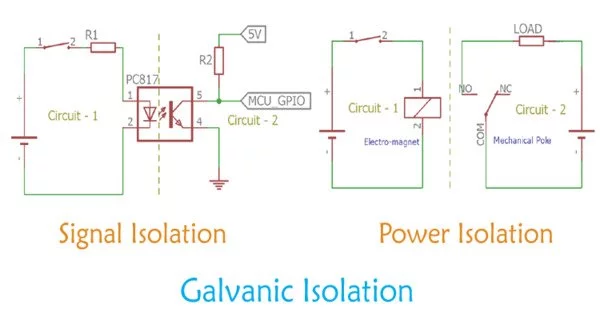Galvanic isolation is a principle of isolating functional sections of electrical systems to prevent current flow; no direct conduction path is permitted. It is a way to isolate functional sections of electrical systems to prevent current flow. It is a brief explanation of differing methods to create galvanic isolation. Energy or information can still be exchanged between the sections by other means, such as capacitive, inductive, radiative, optical, acoustic, or mechanical coupling.
Galvanic isolation is a technique used in electrical and electronic systems to separate or isolate different parts of a circuit to prevent the flow of electric current between them. It is achieved by using a physical barrier or an isolation component, such as a transformer or an optocoupler, to electrically separate the input and output sides of a system.
Galvanic isolation is used where two or more electric circuits must communicate, but their grounds may be at different potentials. It is an effective method of breaking ground loops by preventing unwanted current from flowing between two units sharing a ground conductor. Galvanic isolation is also used for safety, preventing accidental electric shocks.
The primary purpose of galvanic isolation is to provide safety and protect sensitive components or users from potentially harmful or dangerous voltages. It is commonly used in situations where there is a need to connect two circuits that operate at different voltage levels, have different ground references, or are subjected to different electrical noise or disturbances.
Here are some key aspects and benefits of galvanic isolation:
- Electrical safety: Galvanic isolation ensures that high voltages or electrical faults on one side of the isolation barrier do not propagate to the other side, minimizing the risk of electric shock, fire, or damage to equipment and users.
- Noise and interference rejection: Isolation can help mitigate the effects of electrical noise, electromagnetic interference (EMI), or ground loops, which can cause signal distortion, data corruption, or inaccurate measurements.
- Voltage level shifting: Galvanic isolation allows for the connection of circuits with different voltage levels or references. It enables interfacing between systems operating at incompatible voltage ranges, facilitating signal transmission and compatibility.
- Protection of sensitive components: Isolation prevents potentially harmful currents, voltages, or transients from passing between circuits. It protects sensitive electronic components from high voltages, spikes, surges, and other sources of interference.
Galvanic isolation is the separation of electrical systems/subsystems that can flow non-direct current and have different ground potentials. Isolation is classified into two types: power and signal. There are several methods for achieving isolation, and depending on the design requirements, some may be preferred over others.
















